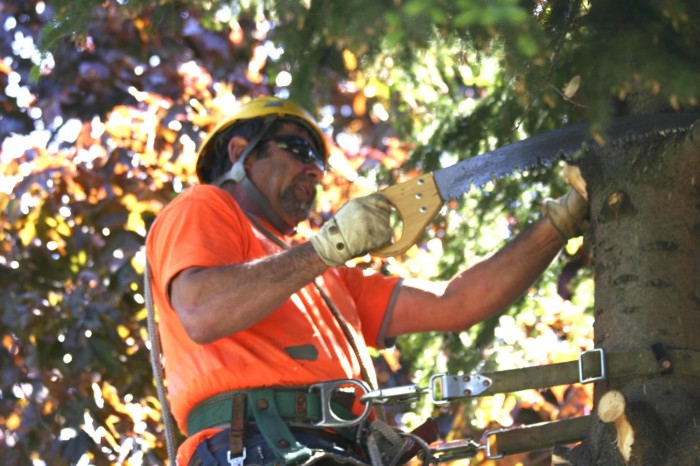Tree removal is a common task performed by homeowners and professionals alike. It may seem like a simple job, but it can be incredibly dangerous if the proper precautions are not taken. According to the Occupational Safety and Health Administration (OSHA), tree care workers have one of the highest fatal injury rates in the country.
In this article, we will explore the risks associated with tree removal and provide important precautions you should take to ensure your safety while performing this task. Whether you’re a professional arborist or just looking to remove a tree from your backyard, it’s crucial that you understand these risks and take appropriate steps to protect yourself and others.
Assessing The Site And Tree Hazard
Before any tree removal project, it is important to assess the site and tree hazards. This will ensure that the work can be carried out safely and effectively. Here are some key factors to consider when assessing a site for tree removal:
- Surroundings:
Look at what is surrounding the tree- are there buildings, power lines or other obstacles that could affect the job? If so, you will need to devise a plan to protect these structures.
- Size:
Consider the size of the tree- larger trees may require more specialized equipment or techniques.
- Condition Of The Tree:
Is it diseased, dead or dying? Trees in poor condition may pose additional risks during removal and may require specific equipment for safe removal.
- Type Of Tree:
Some species are more difficult to remove than others due to their size, root system, or branch structure.
- Ground Condition:
Are there potential hazards on the ground level such as uneven terrain or stumps that could cause injuries?
Once you have assessed these factors, you should develop a plan for removing the tree safely, taking into account all identified hazards. Safety considerations should also include selecting proper safety gear and tools for workers involved in the job.
Remember that assessing risk is crucial at every stage of the tree removal process from beginning to end including transportation of removed fallen trees and log cutting. It is a difficult task to so get help from Tree Wurk who will give services including cutting and trimming trees.
This will help prevent avoidable accidents and keep everyone involved in the project safe while ensuring a successful outcome with minimal damage caused by falling branches and trunk residuals.
Precautions Before Removing A Tree
Before proceeding with the tree removal process, it is crucial to take certain precautions to ensure safety and minimize potential damage. Here are some of the key steps to follow:
- Inspect The Tree:
Inspect the tree for any signs of structural issues such as large cavities or cracks. Assess whether there are any power lines, buildings, fences or other structures nearby.
- Plan An Escape Route:
For safety purposes, it’s essential to plan an escape route in case something goes wrong during the tree removal process. The escape route should be clear of all obstacles and large enough to accommodate all workers.
- Safety Gear:
All personnel working on-site should wear appropriate personal protective equipment (PPE), including helmets, gloves, goggles and sturdy boots with adequate slip-resistant soles.
- Notify Nearby Residents:
Notify your neighbors about your plans beforehand as the process typically involves loud noise and debris scattered around.
- Secure Working Site :
Ensure that your work site is secure by removing any potential tripping hazards and marking off boundaries where necessary with barriers/tapes/flags/signs.
Following these precautions prior to beginning any tree removal project can go a long way in ensuring everyone’s safety and minimizing potential liabilities for accidents occurring at the work site. You can also get tree removal services from professionals for trees that are dead, diseased, structurally compromised, or pose a hazard.
Making A Strategic Plan For Tree Removal
Before cutting down a tree on your property make a strategic plan that covers some key points:
1) Timelines: It’s essential to make a timeline keeping in mind weather conditions or other worker friendliness factors.
2) Documentation/Role allocation: Important documents should be signed addressing insurance coverage, and liabilities if something goes wrong during work. Write up work roles accordingly like climbers/tree cutters/chippers etc.
3) Waste management plan: Lastly come up with an effective waste management plan where the fallen tree will be taken care of.
Conclusion
In conclusion, removing a tree is a task that requires careful consideration and planning to ensure the safety of everyone involved. It’s important to take precautions before tackling this job, such as assessing the site and tree hazards, wearing proper protective gear, and having an emergency plan in place. Making a strategic plan for tree removal can also help minimize potential risks and ensure that the work is carried out efficiently. After the tree has been removed, it’s essential to properly handle stumps, debris, and wood chips to avoid accidents or damages. By following these safety measures, property owners can successfully remove trees while mitigating any hazards that may come with the process.

Be First to Comment